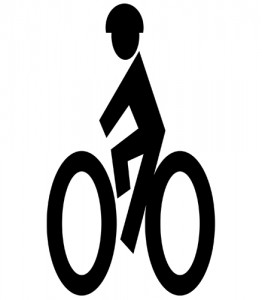Motorized Scooter in a Bike Lane
Question John asked: I have an electric motorized scooter. It has no seat or paddles. Its maximum speed is 18.6 mph. Does it require a driver’s license? I know I’m not allowed to ride it on the road or sidewalk …
 To meet the statute language “a lane marked for bicycle use,” the lane must have this stencil in it.[/caption]
To meet the statute language “a lane marked for bicycle use,” the lane must have this stencil in it.[/caption]
A bicycle lane is a part of the roadway intended to provide bicyclists with a more “comfortable” experience. Feeling safe does not equate to being safe. Research into the relative safety of bike lanes and shared lanes is inconclusive. The Federal Highway Administration does not have a crash reduction factor for bicycle lanes. Bicycle lanes are intended as “preferential use” lanes, not mandatory use lanes (although Florida statute 316.2065(5) now makes their use mandatory, with exceptions for unsafe conditions and situations).
In order to meet the statutory language, the paved area in question must be marked with a bicycle symbol and a directional arrow. There are numerous spaces on area roads that do not meet minimum width standards and other characteristics of correct bike lane design. Bicyclists are permitted to use such spaces, but are not required to. The width of the adjacent lane then determines whether or not the bicyclist is required to share that lane.
The minimum standard width for a bicycle lane is five feet from the lane stripe to the curb face, and a minimum of four feet of asphalt beyond the gutter pan. For state roadways with design speeds 50 mph and higher, the minimum width is 6.5 feet.
— Enforcement for Bicyclist Safety, a publication for law enforcement by MetroPlan Orlando. read online | download pdf
Question John asked: I have an electric motorized scooter. It has no seat or paddles. Its maximum speed is 18.6 mph. Does it require a driver’s license? I know I’m not allowed to ride it on the road or sidewalk …
Question Howard asked: Recently I asked about placing cards on trucks and cars parked in the bike lane. This actually works and I have seen trucks move after finding the cards. I wonder if wearing a patrol belt while riding …
Question Brit asked: Bike lane. I pulled off to side of the rd was at a complete stop. Waiting for my other half to get through the light. Cop showed up lights me up. I Said I was ok. He …
Question Keegan asked: My brother has been to worlds for triathalons for the past 3 years and we both have had question about his training and we haven’t been able to find answers to them for a long time…he trains …
Question Howard asked: Can you place a card stating it is” illegal to park in bike lane” on windshield of car that is parked in the bike lane?
Question Herman asked: Why does the line that separates a bike lane from the travel lane turn to dashed at an intersection?
Question Lisa asked: Can you ride a 49cc scooter in the bike lane in Florida?
Question Sandy asked: I live in Weston, FL, where there are specific bike lanes. However there are “clubs” that ride together, 2-3-4-5 abreast at times that literally take over the entire right lane for drivers of autos. Is this legal?
Question Shannon asked: Is a biker required to use a bike lane even if they do not feel it is safe? For example, in Fort Lauderdale, there is a bike lane going over the 17th street causeway. There is also …
Question Mark asked: If a cyclist is riding in a bike lane or shoulder and come upon a red light, must the cyclist stop if the only intersecting road is on the opposite lane (a T-intersection)? Is there a difference …